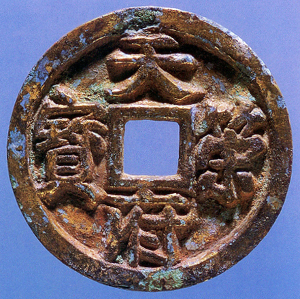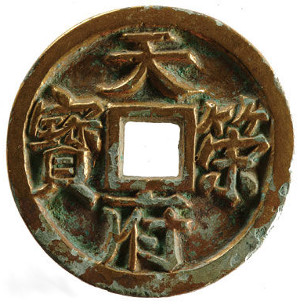Among the rarest of ancient Chinese coins is the tian ce fu bao (天策府宝) coin which was minted by Ma Yin (马殷) of the Kingdom of Chu (楚 907-951) during the Five Dynasties and Ten Kingdoms period.
Both bronze and iron specimens exist.

Very rare Tian Ce Fu Bao gilt bronze coin (National Museum of China)
At the left is an example of a bronze tian ce fu bao.
This coin is particularly rare because it is gilded in gold (鎏金) and only a very few gilt bronze (铜质鎏金) tian ce fu bao coins have been discovered.
Ma Yin began minting these coins in the year 911 to commemorate his promotion to the rank of Supreme Commander of the Tiance Prefecture (天策上将军) as bestowed by Emperor Taizu of Later Liang (后梁太祖).
Both the bronze and iron coins have a nominal value of 10 which means they had a denomination equivalent to ten normal size bronze “cash” coins.
The inscription is read in a clockwise fashion (xuan du 旋读) beginning with the top character.
The characters are deeply cut in regular script (kai shu 楷书) and the coin is well-made.
This coin has a distinctive feature. Regarding the tian (天) character at the top, the vertical line connecting the two horizontal strokes is very short. Most of the other coins exhibit a slightly greater distance between the two horizontal strokes. For this reason, the coin is known as the “short neck Tian” (短颈天) variety.
As mentioned above, this very rare coin has a gold coating although the reason why only a few specimens were treated in this manner is unknown.
Gilt tian ce fu bao coins tend to be slightly larger than the plain bronze coins and the iron coins.
This particular specimen has a diameter of 43 mm and weighs 36.6 grams. The width of the square hole is 9.5 mm and the coin has a thickness of 5.5 mm.
The coin is in the collection of the National Museum of China (中国国家博物馆). It was donated by Mr. Luo Bozhao (罗伯昭) who was one of the most respected Chinese numismatists of the 20th century.

Tian Ce Fu Bao gilt bronze coin (Shanghai Museum)
The Shanghai Museum also has a gilt tian ce fu bao coin.
According to the Shanghai Museum website, this coin has a tian (天) character above the square hole on the reverse side. The website, however, does not show an image of the reverse side of this coin.
I have learned that the Shanghai Museum actually has three of these very rare gold-gilt tian ce fu bao coins.
A Chinese reference book (中华珍泉追踪录) displays rubbings of both the obverse and reverse sides of these three coins. The rubbings do not show a character on the reverse so I believe the Shanghai Museum website is in error.
Regarding the rarity of the coins, Baidu Baike (百度百科), the online encyclopedia of China’s major search engine, states that among the approximately 40 specimens of bronze tian ce fu bao coins known to exist, only 5 are gilded with gold.
Thank you
Thank you for informative and interesting write up. Would appreciate if can elaborate on Gilt Cash Coins.
01. When did it started ? Warring States Period?
02. Is it a common practice or only reserved for Special or High Value Coin?
03. Is the procedure of Gilding Coins difficult or unhealthy as perhaps using Mercury.
Any good Links in English or Mandarin or even Books.
Thank you.